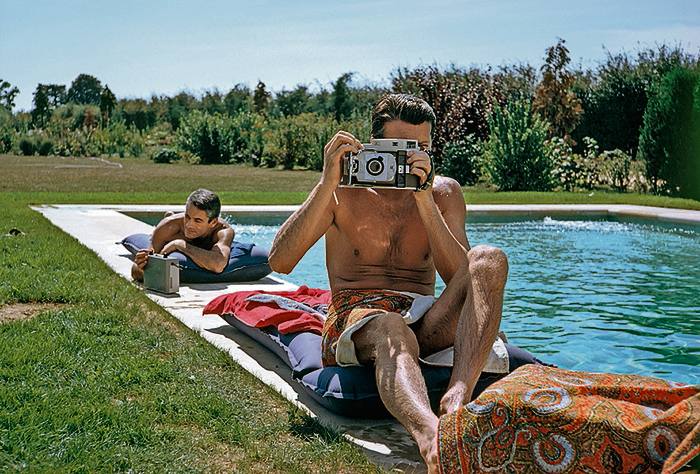Via The Albuquerque Journal
August 4, 2024
By Kathaleen Roberts
Tony Vaccaro photographed a world of beauty from a crucible of pain.
He photographed World War II from a soldier’s eye, documenting its brutality and horror. After carrying his camera across battlefields, he became one of the most sought-after photographers of his day, capturing everyone from Pablo Picasso to Ali MacGraw on film.
Open at Santa Fe’s Monroe Gallery of Photography, “Tony Vaccaro: The Pursuit of Beauty” includes more than 40 photographs dating from 1944 to 1979.
Born in Pennsylvania, Vaccaro spent the first years of his life in the village of Bonefro, Italy, after his family left America under threat from the Mafia. Both of his parents had died by the time he was 8 years old and he was raised by an uncaring aunt and an abusive uncle. His love of photography emerged in Bonefro, where he began taking pictures with a box camera at age 10.
When World War II broke out, he returned to the States, living with his sister in a New York suburb, where he joined his high school camera club. A teacher spotted his talent and guided him through a year of apprenticeship.
Drafted at 21, Vaccaro was determined to continue photographing in combat. He fought on the front lines for 272 days, camera in hand. He entered Germany in 1944. He developed his photographs in combat helmets at night, hanging the negatives from tree branches.
In 1945, he photographed Adolf Hitler’s both sinister and beautiful window at the dictator’s retreat in the Bavarian Alps.
“That massive window was filled with a very thick pane of glass,” said Sidney Monroe, the gallery’s co-owner. “It’s a haunting picture. It’s the ultimate conquest at the end of the war.”
In the years after the war, Vaccaro remained in Germany to photograph the rebuilding of the country for Stars and Stripes magazine. He returned to the U.S. in 1950 and launched a career as a commercial photographer. He worked for Look, Life, Harper’s Bazaar, Town and Country, Newsweek and more.
After the war, he said he had seen enough carnage. He traded beauty for brutality.
In 1960, Vaccaro spent two weeks at Georgia O’Keeffe’s Abiquiú home, photographing her for Look magazine.
“O’Keeffe was pretty notorious for not wanting to be interviewed or photographed,” Monroe said. “So Tony comes out with a writer and she gave them the cold shoulder. O’Keeffe almost wouldn’t talk to him.
“Tony told us at dinner the conversation shifted to bullfighting. O’Keeffe was a fan of a famous Mexican bullfighter that he had photographed. That broke the ice. They bonded and formed a lifelong friendship.”
The photograph captures O’Keeffe’s legendary iconography, the skull between the canales and her rock collection scattered across a shelf.
“She’s in black and wearing her famous belt,” Monroe said. “It incorporates everything we think of when we think of O’Keeffe.”
The show marks the first time the photo has been exhibited.
“Most of the photographs were never published,” Monroe said. “We encouraged him while he was still alive to go to the files.”
Tony Vaccaro
The Guggenheim Hat, New York, 1960
Vaccaro’s famous 1960 “Guggenheim Hat” photograph for Look magazine combines architecture with fashion to make art. The model’s hat mirrors the forms of the Guggenheim Museum.
“The Guggenheim had just really opened,” Monroe said. “At the time, it was sort of an instant classic.”
The model in “Anja on Park Avenue” became Vaccaro’s wife. Her heavily-patterned gown mimics the lights on the Pan Am building behind her. The Swedish designer Marimekko was known for its bold patterning. The photo has never been seen before.
In Venice, Italy, Vaccaro photographed Peggy Guggenheim leaving her home in a gondola in 1968. She was starting her museum in Venice.
Tony Vaccaro
Peggy Guggenheim, Venice, Italy, 1968
“She had a big house there that held her art collection,” Monroe said. “She was fabulously eccentric.”
The photo captures an angry Guggenheim hiding something beneath her blue cape.
Her yard featured a large bronze sculpture of a rearing horse.
The horse has a penis and the penis was removable.
A school group was about to enter the yard.
“She removed the penis,” Monroe said. “That is under the cape. He wanted her to show it; that’s why she looks mad. It’s a wonderful marriage of subject and place.”
In 2022, Monroe and his wife and business partner Michelle celebrated Vaccaro’s 100th birthday in New York. The city of New York declared it “Tony Vaccaro Day” and he was feted at his favorite Italian restaurant. He died eight days later, after surviving the Battle of Normandy and two bouts of COVID. He attributed his longevity to “blind luck, red wine and determination.”
Tony Vaccaro
Safe Trip! 1957
'Tony Vaccaro: The Pursuit of Beauty'
WHEN: 10 a.m. to 5 p.m. daily; through Sept. 15
WHERE: Monroe Gallery of Photography, 112 Don Gaspar, Santa Fe
MORE INFO: monroegallery.com; 505-992-0800










